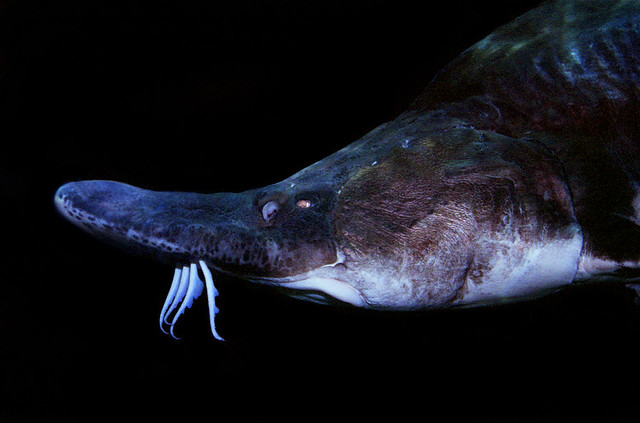Cladus: Eukaryota Vernacular Name The beluga /bəˈluːɡə/ or European sturgeon (Huso huso) is a species of anadromous fish in the sturgeon family (Acipenseridae) of order Acipenseriformes. It is found primarily in the Caspian and Black Sea basins, and occasionally in the Adriatic Sea. Heavily fished for the female's valuable roe—known as beluga caviar— the beluga is a huge and late-maturing fish that can live for 118 years.[2] The species' numbers have been greatly reduced by overfishing and poaching, prompting many governments to enact restrictions on its trade. The most similar to the Huso huso Beluga is the Huso dauricus Kaluga, also referred to as the "River Beluga". The common name for the sturgeon, as for the unrelated beluga whale, is derived from the Russian word белый (belyy), meaning "white". Behaviour The beluga is a large predator which feeds on other fish. As do many sturgeons, the beluga travels upstream in rivers to spawn. Accordingly, sturgeons are sometimes likened to sea fish; however most scientists consider them to be river fish. Size The largest generally accepted record is of a female taken in 1827 in the Volga estuary at 1,476 kg (3,250 lb) and 7.2 m (24 ft),[3] making the beluga the largest freshwater fish in the world; larger even than the Mekong giant catfish or the Arapaima. Nevertheless, some scientists still consider the Mekong giant catfish to be the largest freshwater fish, owing to sturgeons' ability to survive in seawater. Beluga of such great sizes are always very old (continuing to grow throughout life) and have become increasingly rare in recent decades due to the heavy fishing of this species. Today, Belugas that are caught are generally 142–328 cm (4.66–10.76 ft) long and weigh 19–264 kg (42–580 lb). The female beluga is typically 20% larger than the male.[4] Caviar Beluga caviar is considered a delicacy worldwide. The meat of the beluga, on the other hand, is not particularly renowned. Beluga caviar has long been scarce and expensive. The endangered status of the fish has made its caviar more expensive than before. (See beluga caviar.) Status IUCN classifies the beluga as critically endangered. It is a protected species listed in appendix III of the Bern Convention and its trade is restricted under CITES appendix II. The Mediterranean population is strongly protected under appendix II of the Bern Convention, prohibiting any intentional killing of these fish. The United States Fish and Wildlife Service has banned imports of Beluga Caviar and other beluga products from the Caspian Sea since October 6, 2005. The United States banned import of beluga caviar in 2006 after listing beluga sturgeon under the U.S. Endangered Species Act.[5] References ^ Sturgeon Specialist Group (1996). "Huso huso". IUCN Red List of Threatened Species. Version 2009.1. International Union for Conservation of Nature. Retrieved 28 October 2009. "Huso huso". Integrated Taxonomic Information System. Retrieved 24 January 2006.
Source: Wikispecies: All text is available under the terms of the GNU Free Documentation License |
|

